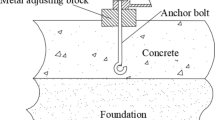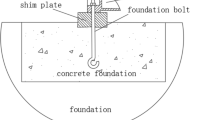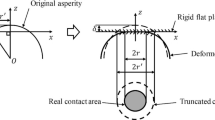Abstract
The heavy-duty machine tool is usually assumed in the concrete foundation, in which the machine tool-foundation joints have a critical effect on the working accuracy and life of heavy-duty machine tool. This paper proposed a novel contact stiffness model of concrete–steel joint based on the fractal theory. The topography of contact surface exist in concrete–steel joint has a fractal feature and can be described by fractal parameters. Asperities are considered as elastic, plastic deformation in micro-scale. However, the asperities of concrete surface will be crushed when the stress is larger than their yield limit. Then, the force balance of contact surfaces will be broken. Here, an iteration model is proposed to describe the contact state of concrete–steel joint. Because the contact asperities cover a very small proportion (less than 1%), the load on crushed asperities is assumed carried by other no contact asperities. This process will be repeated again and again until the crushed asperities are not being produced under external load. After that, the real contact area, contact stiffness of the concrete–steel joint can be calculated by integrating the asperities of contact surfaces. Nonlinear relationships between contact stiffness and load, fractal roughness parameter G, fractal dimension D can be revealed based on the presented model. An experimental setup with concrete–steel test-specimens is designed to validate the proposed model. Results indicate that the theoretical vibration mode shapes agree well with the experimental variation mode shapes. The errors between theoretical and experimental natural frequencies are less than 4.18%. The presented model can be used to predict the contact stiffness of concrete–steel joint, which will provide a theoretical basis for optimizing the connection characteristic of machine tool-concrete foundation.














Similar content being viewed by others
References
Ibrahim, R.A., Pettit, C.L.: Uncertainties and dynamic problems of bolted joints and other fasteners. J. Sound Vib. 279(35), 857–936 (2005)
Gonzalez-Valadez, M., Baltazar, A., Dwyer-Joyce, R.S.: Study of interfacial stiffness ratio of a rough surface in contact using a spring model. Wear 268(3/4), 373–379 (2010)
Daisuke, K., Takahiro, I., Atsushi, M., et al.: Stiffness model of machine tool supports using contact stiffness. Precis. Eng. 37(3), 650–657 (2013)
Majumdar, A., Bhushan, B.: Fractal model of elastic–plastic contact between rough surfaces. ASME J. Tribol. 113(1), 1–11 (1991)
Wang, S., Komvopoulos, K.: A fractal theory of the interfacial temperature distribution in the slow sliding regime, part I: elastic contact and heat transfer analysis. ASME J. Tribol. 116(4), 812–823 (1994)
Fu, W.P., Huang, Y.M., Zhang, X.L., et al.: Experimental investigation of dynamic normal characteristics of machined joint surfaces. ASME J. Vib. Acoust. 122(4), 393–398 (2000)
Ren, Y., Beards, C.F.: Identification of effective linear joints using coupling and joint identification techniques. ASME J. Vib. Acoust. 120(2), 331–338 (1998)
Jiang, S., Zheng, Y., Zhu, H.: A contact stiffness model of machined plane joint based on fractal theory. J. Tribol. 132(1), 0114011–0114017 (2010)
Komvopoulos, K., Ye, N.: Elastic–plastic finite element analysis for the head–disk interface with fractal topography description. J. Tribol. 124, 775–784 (2002)
Kogut, L., Etsion, I.: A static friction model for elastic–plastic contacting rough surfaces. J. Tribol. 126(1), 34–40 (2004)
You, J.M., Chen, T.N.: A static friction model for the contact of fractal surfaces. Proc. Inst. Mech. Eng. Part J J. Eng. Tribol. 224(5), 513–518 (2010)
Diamond, S.: Aspects of concrete porosity revisited. Cem. Concr. Res. 29(8), 1181–1188 (1999)
Majumdar, A., Bhushan, B.: Role of fractal geometry in roughness characterization and contact mechanics of surfaces. ASME J. Tribol. 112(2), 205–216 (1990)
Borodich, F.M., Onishchenko, D.A.: Similarity and fractality in the modelling of roughness by a multilevel profile with hierarchical structure. Int. J. Solids Struct. 36(17), 2585–2612 (1999)
Yan, W., Komvopoulos, K.: Contact analysis of elastic–plastic fractal surfaces. J. Appl. Phys. 84(7), 3617–3624 (1998)
Greenwood, J.A., Williamson, J.B.P.: Contact of nominally flat surfaces. Proc. R. Soc. Lond. 295(1442), 300–319 (1966)
Ji, C.C., Zhu, H., Jiang, W.: Fractal prediction model of thermal contact conductance of rough surfaces. Chin. J. Mech. Eng. 26(1), 128–136 (2012)
Da, B., Yu, H., Ma, H., Tan, Y., Mi, R., Dou, X.: Experimental investigation of whole stress–strain curves of coral concrete. Constr. Build. Mater. 122, 81–89 (2016)
Nematzadeh, M., Salari, A., Ghadami, J., Naghipour, M.: Stress–strain behavior of freshly compressed concrete under axial compression with a practical equation. Constr. Build. Mater. 115, 402–423 (2016)
Pan, Z., Li, B., Lu, Z.: Re-evaluation of ceb-fip 90 prediction models for creep and shrinkage with experimental database. Constr. Build. Mater. 38(2), 1022–1030 (2013)
Komvopoulos, K., Gong, Z.Q.: Stress analysis of a layered elastic solid in contact with a rough surface exhibiting fractal behavior. Int. J. Solids Struct. 44(7–8), 2109–2129 (2007)
Buczkowski, R., Kleiber, M., Starzyński, G.: Normal contact stiffness of fractal rough surfaces. Arch. Mech. 66(6), 411–428 (2014)
Wen, S.: Fractal model of tangential contact stiffness of joint interfaces and its simulation. Trans. Chin. Soc. Agric. Mach. 40(12), 223–227 (2009)
Wang, T., Wang, L., Zheng, D., Zhao, X., Gu, L.: Numerical simulation method of rough surfaces based on random switching system. J. Tribol. 137(2), 021403 (2015)
Goerke, D., Willner, K.: Normal contact of fractal surfaces—experimental and numerical investigations. Wear 264(7–8), 589–598 (2008)
Poljacek, S.M., Risovic, D., Furic, K., Gojo, M.: Comparison of fractal and profilometric methods for surface topography characterization. Appl. Surf. Sci. 254(11), 3449–3458 (2008)
Acknowledgements
This work was supported by General Project of Science and Technology Program of Beijing Education Committee (CN) (No. SQKM201710005016), National Natural Science Foundation (No. 51575009), Jing-Hua Talents Project of Beijing University of Technology (CN), Large scientific research promotion program of Beijing University of Technology (CN) and Beijing Science and Technology Major Project (No. D17110400590000).
Author information
Authors and Affiliations
Corresponding author
Ethics declarations
Conflict of interest
The author(s) disclosed no potential conflicts of interest with respect to the research, authorship, and/or publication of this article.
Rights and permissions
About this article
Cite this article
Zhao, Y., Wu, H., Liu, Z. et al. A novel nonlinear contact stiffness model of concrete–steel joint based on the fractal contact theory. Nonlinear Dyn 94, 151–164 (2018). https://doi.org/10.1007/s11071-018-4350-7
Received:
Accepted:
Published:
Issue Date:
DOI: https://doi.org/10.1007/s11071-018-4350-7




